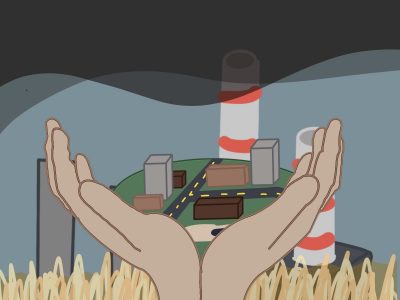For my last column I wrote about how the development of new technology impacts the physical look of a town over time, but looks aren’t everything. Technology has a profound impact on employment, the not-so-glamorous lifeblood of a city. When the profitable industries become no longer profitable, the workers of that industry are often left in the dust. Such is the case of Gary, Indiana.
When I decide on a “small town” to write about for this column, I have a somewhat arbitrary cutoff of a population over 100,000. Gary, had I been writing this column 20 years ago, would have beat the cutoff. Now, 60 years after its peak population of 178,000, Gary, Indiana has fallen to a population of less than 70,000, a tragedy well worth discussion.
Gary, at one point a blossoming town in the Chicago Metropolitan Area, was founded in 1906 by the U.S. Steel Corporation. From its inception, the town was supported by the behemoth of middle class factory jobs that were at one point much more common in this country.
Gary is one of many manufacturing towns that suffered a similar fate after a constant decline in employment opportunities in the second half of the 20th century. Pittsburgh, the headquarters of U.S. Steel, has lost over 60% of its population since the 1950s.

Nowadays, a drive down Broadway will give a good idea of what Gary has been through. Beginning at the mouth of the U.S. Steel Gary Works, you’ll pass through block after block of dilapidated retail spaces. Large brick buildings with their edifices eroding and boarded up first floors become canvases for street art and murals.
It’s important to learn from the instability of single-industry towns like Gary. Tech companies are proving themselves to be the next big large hiring companies capable of making — or breaking — the wellbeing of a metro area. Huntsville, Alabama is a prime example of these new population surges. The city, whose population just broke 200,000, has nearly 25% of its workforce employed in the tech industry.
Our increasingly virtual work environments may speak to some semblance of longevity for employment in tech fields, but the future is never certain. In the event that tech companies decide to outsource talent, these newly-minted metropolises might suffer a fate similar to Gary. Larger cities like Denver and Austin are diverse enough in employment to bounce back from a dip in the tech market, but a place like Huntsville may not be so fortunate.
Similar declines can even be seen on a smaller level in college towns which face decreasing enrollment. Numerous college towns in Illinois, DeKalb for example, faced noticeable drops in population following the 2020 census. When the major employing universities of these cities face lowering enrollment rates, the economic impact is felt throughout the entire community.
Gary, Indiana and its rust belt companions all felt the same catastrophic loss when the United States fell from its manufacturing height, but it is not too late to learn from their experiences. Attracting high-tech employers does wonders for the local economy right now, but relying too heavily on a single industry will always be unstable.
For their part, many people in Gary are putting in a great effort toward economic revitalization in their home. The Aetna Manor Revitalization Program is one such non-profit currently working to provide employment and community services in the Aetna Manor neighborhood area.
One of Gary’s many murals, on the corner of 6th avenue and Broadway, sends a message of joy and hope that things are turning around for the local community. In colorful block letters, it reads, “We are beautiful: Gary.” I, for one, agree.




















































































































John Jon • Mar 17, 2022 at 9:58 am
The mural/building mentioned in the article is no longer standing.